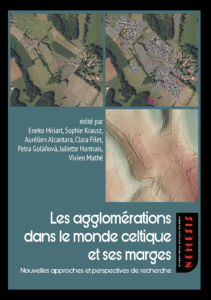UN@ est une plateforme d'édition de livres numériques pour les presses universitaires de Nouvelle-Aquitaine
Auteur : Petra Goláňová

Department of Archaeology and Museology
Faculty of Arts, Masaryk University
Arna Nováka 1
602 00 Brno
Czech republic
golanova@phil.muni.cz
0000-0002-5113-4039
Faculty of Arts, Masaryk University
Arna Nováka 1
602 00 Brno
Czech republic
golanova@phil.muni.cz
0000-0002-5113-4039
Petra Goláňová is a researcher with specialization on Iron Age in Europe. She is particularly interested in Early La Tène period, specialized production, art and elites. Other research focus is Late La Tène period, as she participates since 2010 at the excavations in oppidum Bibracte.
References
- HAJNALOVÁ, Mária, Petra GOLÁŇOVÁ, Eva JAMRICHOVÁ, Libor PETR, Markéta FRÁNKOVÁ, Peter BARTA, Romana KOČÁROVÁ, Patrik FLAMMER and Akos PETO. Land cover and use‑history of large empty spaces at fortified Iron Age hilltop sites; a case study from La Terrasse, Bibracte oppidum. VEGETATION HISTORY AND ARCHAEOBOTANY. UNITED STATES: SPRINGER, 2023, vol. 2023, online, p. 1-20. ISSN 0939-6314. doi:10.1007/s00334-023-00934-0.
- LISÁ Lenka, MOHAMMADI Sahar, GOLÁŇOVÁ Petra, HAJNALOVÁ Mária, BAJER Aleš, MOSKA P., ROHOVEC J., KRÁL J., KYSELA Jan, KOČÁROVÁ Romana: Detection of occupational surface remnants at a heavily eroded site; case study of archaeological soils from La Terrasse, Bibracte oppidum. Catena 210 (2022) 105911, 18 str. Elsevier Ltd, 2021. https://doi.org/10.1016/j.catena.2021.105911
- GOLÁŇOVÁ, Petra a Miloš HLAVA. Something went wrong: on the bronze chain-belt rejects from Čejkovice (Hodonín district, CZ). Slovenská archeológia – Supplementum 2. 2021, roč. 2, No. 1, p. 121-127. doi:10.31577/slovarch.2021.suppl.2.11.
- GOLÁŇOVÁ, Petra. The Invisible Early La Tène Elites in Moravia? Evidence from a Bronze Flagon Mount Found at Pavlov-Děvín (Okr. Břeclav / CZ). Archäologisches Korrespondenzblatt : Urgeschichte, Römerzeit, Frühmittelalter. Verlag P. von Zabern., 2021, vol. 51, No. 3, p. 351-369. https://doi.org/10.11588/ak.2021.3.90873
- GOLÁŇOVÁ, Petra, Mária HAJNALOVÁ, Lenka LISÁ, Peter MILO, Libor PETR, Markéta FRÁNKOVÁ, Jan KYSELA, Patrik G FLAMMER, Romana KOČÁROVÁ and Peter BARTA. Investigating the complex story of one ditch — A multidisciplinary study of ditch infill provides insight into the spatial organisation within the oppidum of Bibracte (Burgundy, France). PLoS ONE. 2020, vol. 15, No 4, p. 1-32. https://doi.org/10.1371/journal.pone.0231790
- CABANILLAS DE LA TORRE, Gadea and Petra GOLÁŇOVÁ. ‘Copy and Paste’ in the Iron Age : Stamped Pottery between Local Production and the Continental Scale. In Pierrevelcin, Gilles; Kysela, Jan; Fichtl, Stephan. Unité et diversité du monde celtique : unity and diversity in the Celtic world : actes du 42e colloque international de l’AFEAF (Prague, 10-13 mai 2018). Paris: AFEAF 2020, 2020. p. 217-234.
- GOLÁŇOVÁ, Petra, Balázs KOMORÓCZY, Matěj KMOŠEK, Eva KOLNÍKOVÁ, Marek VLACH and Michaela ZELÍKOVÁ. New metal and glass finds from the Late Iron Age in South Moravia (CZ). The contribution of citizen science to knowledge of the La Tene settlement structure in the Břeclav Region. Přehled výzkumů. AV ČR, Archeologický ústav, 2020, vol. 61, No 2, p. 9-41. https://doi.org/10.47382/pv0612-05
- GOLÁŇOVÁ, Petra and Jan KYSELA. What can the dwarfs tell? On settlements and anthropomorphic statuary in La Tene Southern Moravia. Studia Historica Nitrensia. Nitra: Univerzita Konštantína Filozofa v Nitre, 2019, vol. 23, Supplementum, p. 71-92. https://doi.org/10.17846/SHN.2019.23.S.71-92
- GOLÁŇOVÁ, Petra. The Early La Tene Period in Moravia. Bonn: Habelt-Verlag, 2018. 311 pp. Studien zur Archäologie Europas 32.
Mots clés
Archaeology, Iron Age, Oppida, Iron Age Art
En Europe tempérée, les premières villes apparaissent plus tardivement que dans le monde méditerranéen. Elles se développent dans des contextes différents sur les plans économiques et politiques et selon des dynamiques qui leur sont propres. On a longtemps pensé que les oppida, habitats fortifiés de hauteur, qui émergent à la fin du IIe s. a.C. représentaient les premières villes du domaine celtique (plus précisément laténien).
Our original intention was to present the state of research on open agglomerations in the territory of the Czech Republic besides the site of Němčice which is generally known and which is presented separately in the present proceedings.


